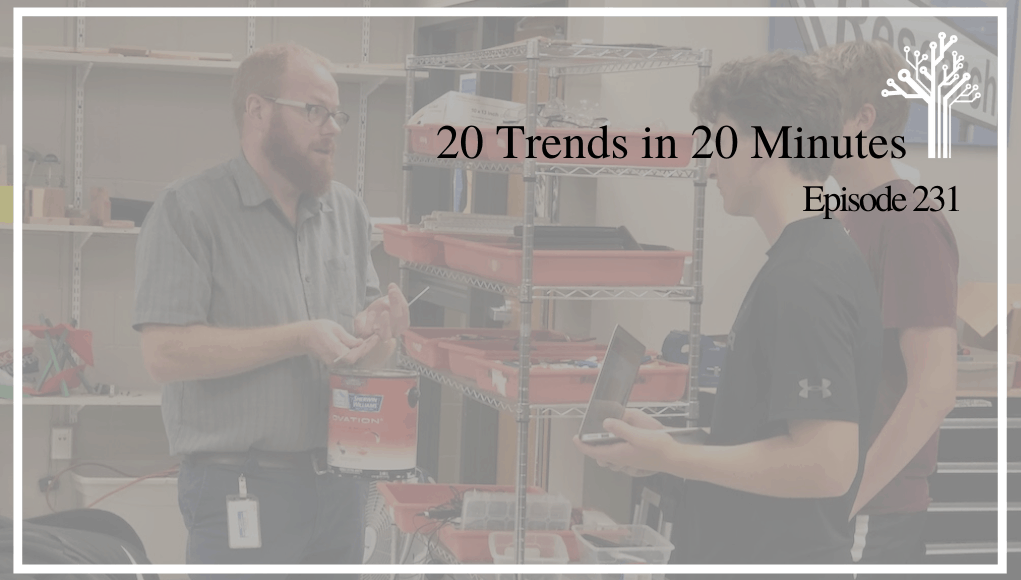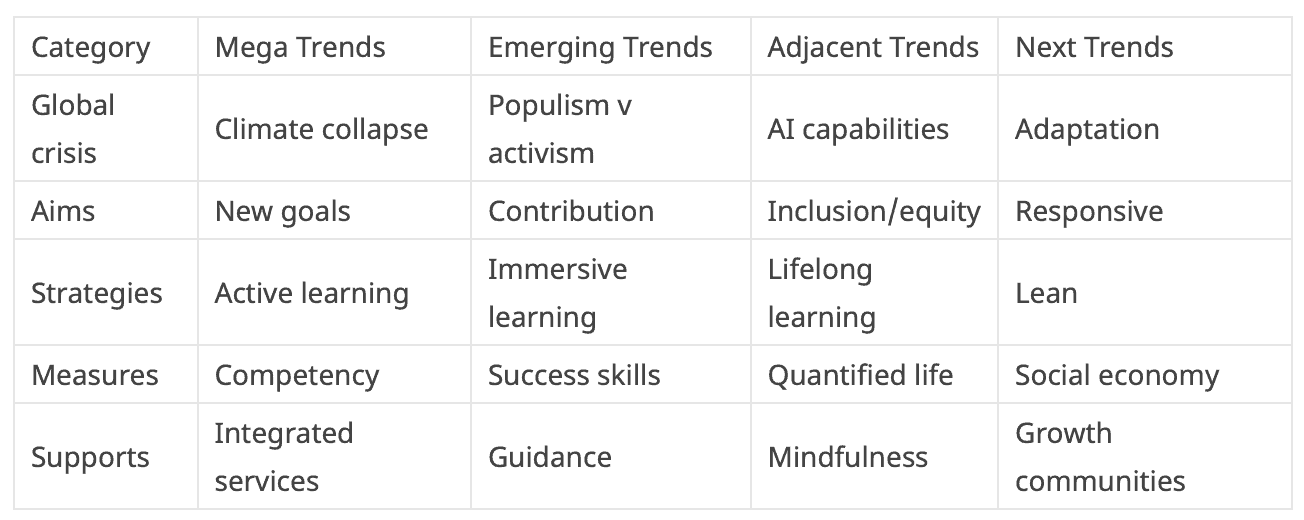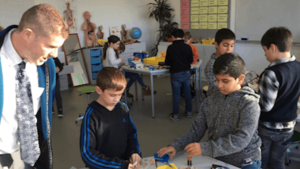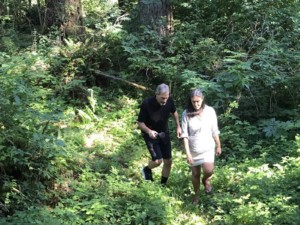Podcast: 20 Trends in 20 Minutes

The world of work and the communities we share are changing fast–so are the opportunities to engage learners. With new challenges and fresh opportunities, It’s such an interesting time to be in education
In a summer series, we reviewed four megatrends, four emerging trends, four adjacent trends, and four future trends. We concluded with a global change force–the warming planet–and four ways it will influence education.
4 Mega Trends
1. New Goals: There is a global reconsideration of learning goals and ‘graduate profiles’ based on the new economy (what the World Economic Forum calls the Fourth Industrial Revolution). There are lots of folks asking: What Should Graduates Know and Be Able to Do?
International advocate iNACOL urges “engaging our communities in the conversations around new definitions of success and what is necessary for redefining student success to include academic competencies, social-emotional competencies, skills and dispositions with a holistic focus for the whole child, well-rounded education and the future of our communities.”
Purdue Polytechnic and 18 other groundbreaking schools aim at XQ Learner Goals which adds ‘original thinkers’ and ‘generous collaborators’ and to foundational knowledge and literacies.
Schools are beginning to join networks like Building 21 around next-gen essentials— collaboration, communication, presentation—as well as habits of success, personal development, and wayfinding.
We appreciate Seth Godin’s concise summary: leadership and solving interesting problems are the two most important things to learn.
2. Active Learning: There is a global trend toward combinations of personalized and project-based learning. Individualized skill building has been bolstered by adaptive and small group instruction. Extended challenges are more frequently being used to develop the personal leadership and problem-solving skills valued by new outcome frameworks (#1).
Active learning is more student-centered, with a combination of directed tasks and open-ended challenges that provide more learner voice and choice. Rural learners in the Place Network use design thinking to take on community challenges.
“Active learning beats passive learning when it comes to students understanding concepts and retaining information and skills,” said Tracy Gardner, a teaching professor in chemical and biological engineering at Colorado School of Mines. In the same department, Michael Barankin also uses a variety of blended strategies with a focus on communication in and out of the classroom. Student projects begin by reaching out to industry partners, developing a plan, forming teams, generating progress reports and delivering a final presentation.
Schools are developing more flexible and welcoming active learning environments that support individual, team and group experiences, and dynamic scheduling.
3. Competency: There is a global shift from seat time to ‘show what you know’ and progress on demonstrated mastery. It’s a complex shift that will take a few decades to play out as new tools, strategies and measures are developed. It’s moving most quickly around dynamic job clusters where an academic pedigree matters less than what you can do.
Lumina Foundation sees “competencies as currencies” and advocates hiring focused on skills rather than degrees. TechHire is a national network promoting skill-based hiring.
Badges can be a better way of organizing units of learning and measuring and communicating capabilities than time-based courses. An early leader in creating badges, IBM has issued over a million credentials to learners within and outside the company. Online learning leader Southern New Hampshire University acquired youth badging platform LRNG to extend access and create new pathways to credentials, degrees, and opportunity.
Similarly, a growing number of teachers are benefiting from personalized and competency-based learning organized as a series of microcredentials. Teachers gain the ability to choose (or build) what they wish to learn and how they demonstrate their learning.
More than 300 schools have formed the Mastery Transcript Consortium to move from a list of courses to a richer description of capabilities. Arizona State University is working on a blockchain transcript to facilitate portability—so is a startup supporting Dallas high schools.
4. Integrated Supports: Toni Barton of Relay Graduate School sees a “bright future in which students’ differences are celebrated, their unique needs are met, and the entire system is geared toward advancing students’ academic and socio-emotional growth.” In the meantime, the growth of integrated support systems is helping to make our inherited system of age cohorts work better for more students.
In 2014, Child Trends called integrated student supports a critical but emerging trend. By 2017, they announced that the number of schools offering a web of youth and family services had grown in number and in evidence of importance.
Many higher education institutions including Georgia State and Florida State have improved completion rates with integrated supports. A systemic approach to stronger advising and student services is summarized in a toolkit from Achieving the Dream.
The combination of new goals, active learning strategies, competency-based progressions and integrated services is boosting learner success.

Four Emerging Trends
Building on the four megatrends are four emerging trends: a focus on contribution, immersive learning, a focus on success skills, and thoughtful guidance.
1. Contribution: “Everyone deserves an education that is about their own development as a human being,” said Peter Senge. “The purpose of education is for me to become me in the context of the society in which I live, so I can truly contribute to my society.
Investor-turned-advocate Ted Dintersmith said, “School should be about finding out what you’re good at—preparing for lives of purpose, lives of contribution.”
We think a contribution is a new superpower–it’s delivering value and making a difference, it combines the problem finding of an entrepreneurial mindset with a customer focus on design thinking.
At the 20-year-old purpose-built Olin College, “doing good for humanity” is a founding precept. A growing number of engineering schools incorporate entrepreneurial mindset (spotting opportunity and delivering value) and doing good in the world.
“Empowering all students to make meaningful contributions to the world.” That’s the remarkable motto of the Loudoun County Public Schools (LCPS). He believes in “engaging students in solving authentic problems as a means to developing as knowledgeable critical thinkers, communicators, collaborators, creators, and contributors.”
2. Immersive Learning: Powerful learning experiences are often immersive. A growing number of K-12 schools are leveraging the power of place to explore the ecological, cultural and economic aspects of a community.
Teton Science School in Wyoming is a leader in place-based education and launched the Place Network to help rural schools boost student engagement, academic outcomes, and local impact by using the community as classroom.
Virtual reality (VR) is bringing the power of place to classrooms. Google Expeditions enables students to explore the world with an inexpensive viewer. VR is becoming widely used in job training where simulation is beneficial as well.
Mobile technology has made it easier to extend project-based learning from the classroom to the community. Smartphones with GPS, cameras, and sensors allow learners to document community investigations. Augmented reality (AR) applications will soon allow learners to immerse themselves not only in local environments but in the associated data sets. Imagine a neighborhood survey (like those conducted at NuVu Studio) that one day considers economic data and another day environmental data. With AR, students can experience such findings in a more personal and memorable way.
Increasing focus on work-based learning is another example of immersive learning. The Imblaze app from Big Picture Learning helps schools manage internships and enables teachers to monitor their students’ location and progress.
3. Success Skills: Many new outcome frameworks (#1 megatrend) prioritize agency and collaboration—that is, the ability to manage yourself and your relationships. The emerging trend measures these important dispositions critical to the future of work, where students may find themselves regularly working autonomously in addition to collaborating with remote colleagues.
Survey instruments are becoming widely used in measures of school culture and climate. While they provide useful data points, they don’t chart individual students’ growth in important dimensions. What’s promising is a new generation of metrics embedded in powerful learning experiences.
The 200 project-based schools in the New Tech Network assess agency and collaboration in every project.
4. Guidance: The employment landscape is being transformed by the innovation economy and there’s been an explosion of associated secondary and postsecondary learning options. Helping learners make good decisions about what to learn and how to learn it is becoming more important every day. Widely used information systems provide generic advice, but not personalized and localized guidance. Smart services that combine informed advisors and comprehensive information systems are just beginning to appear.
EL Education offers a character framework that helps young people develop purpose, agency and belonging so that they can contribute to a better world. Schools in the EL network all start with Crew, a daily advisory period where learners check in with advisors, build culture, develop success skills, and receive thoughtful guidance on the next steps in learning.
The World of Work, developed with the Cajon Valley Union School District, is a systematic K-8 introduction to career options and an exploration of personal values, strengths, and interests.
Building on the four megatrends, these emerging trends are making learning more engaging, more purposeful and more impactful for the long term.
Four Trends Influencing Education
This section considers four adjacent trends that are impacting society at large and, as a result, are impacting education directly and indirectly–and mostly for good.
1. Inclusion and equity: Organizations nationwide, even worldwide, are coming to terms with the unfinished business of race, inclusion, diversity, and equity. Rapid social progress on LGBTQ rights and visible campaigns (e.g., #BlackLivesMatter, #MeToo) in response to unaddressed inequity have caused learning institutions to reconsider their culture, practices, and policies.
In 2017, NewSchools Venture Fund studied race, inclusion, diversity, and equity in education organizations and identified big gaps. In response, they have been promoted to diverse leadership. Education Board Partners is helping nonprofit boards become more representative.
Carlos Moreno just hosted a five-part series on race for Big Picture Learning and spoke about it at their annual conference. His efforts are representative of a high percentage of school districts and networks trying hard to be more inclusive and to promote more equitable results.
2. Lifelong Learning: About ten years ago, there was a widespread recognition that learning for a period of 16 years and then working for 40 years didn’t work anymore—that learning must be ongoing to adapt to the innovation economy.
In 2015, “Learners for Life” was one of the five XQ Learner Goals framing the big grant competition that sought to reinvent high school. They defined the goal as “Self-driven, self-directed. Curious learners—about themselves, and the world. Inventors of their own learning paths, careers, and lives.”
For schools, the lifelong learning trend means helping learners to become more aware of how they learn best and cultivating productive learning habits including journaling and curating a portfolio. It means more voice and choice in learning, and less routine and compliance. For post-secondary institutions, the trend means catering to the needs of adult learners and cultivating long-term learning relationships.
For post-secondary institutions, it means leaning into learning relationships–for life. In the 2020s, one way or another, almost everyone will be on an earn-and-learn ladder.
3. Quantified Life: About a quarter of U.S. adults use some kind of tracker. Beyond fitness, consumers are seeing more comprehensive information about the weather, their health, their driving, their screen time. With sensors and cameras everywhere, it’s 24/7 surveillance with few agreements in place.
For schools, the shift from print to digital learning has produced a dramatic increase in the amount of formative feedback to learners (although a lack of interoperability currently impedes its usefulness). Schools can help students cope with the quantified life by learning how to monitor their own data and take ownership of their learning profiles.
4. Mindfulness: Top performers in every field frequently use some kind of mindfulness routine. It’s part of a broader wellness movement illustrated by Arianna Huffington’s founding of Thrive Global.
Schools worldwide are adopting broader goals (megatrend #1) that frequently incorporate social and emotional learning and that can often incorporate practices of mindfulness.
A well-respected example in secondary education is Compass, a holistic human development program from Valor Collegiate Academies in Nashville and now adopted by networks across the country. Compass has four directions—Aligned Actions, Big Heart, Sharp Minds, Noble Purpose—culminating in a fifth, True North. The school day starts in Circles, a safe place to build trust, allow people to fully be themselves and to create community. It includes mindfulness and intentional facilitation that helps learners gain control of their own behavior and collaborate with others.
These four trends—inclusion, lifelong learning, quantified self and mindfulness—are becoming ubiquitous in the media and becoming part of the culture. Many schools are trying to understand what they mean for practices and reporting.
Four Future Trends
Driven by the innovation economy, four trends will become important for system leaders in the 2020s.
1. Responsive: “Education systems must also become much more responsive, providing seamless educational opportunities grounded in the mastery of academic fundamentals and by experiences relevant to an ever-evolving, increasingly connected world.” That’s a recommendation from The Age of Agility, a report from America Succeeds.
Being “nimble and agile,” as America Succeeds recommends, requires education institutions to be in an ongoing conversation with key stakeholders and facilitating a set of temporary agreements about updated learning goals (the number one mega trend) and renewing a commitment to equity as demographics change (the number one adjacent trend).
High schools and career education institutions have to be highly responsive to local and global trends in high wage high demand employment. Many career centers and community colleges have active business advisory councils that help fulfill this need.
2. Lean: In most states, there is no new money coming to public education—K-12 or higher ed—and in many areas enrollments are flat or declining because of lower birth rates and more competition–not a pleasant combination for system heads. It’s time to get lean to deal with declining budgets (or in preparation of likely declines).
Lean software development is a customer-centric methodology that seeks to eliminate waste and add value. There are at least a dozen service delivery opportunities and artificial intelligence-powered tools for staffing, scheduling and transportation will become helpful in lean efforts in the near future.
In the next decade, we’ll see a few school districts sell off their facilities to a group like WeWork to gain flexibility. Rideshare services and autonomous vehicles will help school districts develop lean transportation systems.
3. Social economy: The gig economy is driven by platforms that enable value exchanges. First, it was stuff (eBay and Amazon), then underutilized assets (Airbnb and Uber), and now hours (Thumbtack, TaskRabbit, and Upwork). Next will be measured efficacy—data will tell the value creation story of how well one person supports the growth of another.
The social economy will be built on the traits that make us uniquely human: care, consideration, creativity, and critical thinking. Like the shift from seat time to competency in learning, the shift from selling hours to measured efficacy will unlock latent energy in the social economy. Initially, platforms will include a dashboard of proxy measures. Over time, systems that accurately gauge contributions to growth and well-being will improve.
4. Growth communities: For hundreds of years, formal education has been organized as knowledge transmission to age cohorts. Artful teachers and advisors can convert cohorts to learning communities with a sense of belonging and mutuality.
Growth communities add learner agency to that idea—the ability to dynamically organize around common goals.
“Imagine an educational system that privileges local value creation, that empowers communities to identify learning priorities and local champions, and then assembles learners to work on goals that matter to them,” says ASU’s Sasha Barab (in an upcoming book). “Such a framework begins with understanding what communities and individual learners want to achieve, and what local strengths can be tapped into and amplified.”
This principle of high agency, high mutuality is also expressed in the youth badging platform LRNG and Seth Godin’s altMBA.
As competency systems (megatrend #3) unlock anywhere, anytime learning, we’ll see more growth communities formed around powerful experiences with the ability to capture and communicate new capabilities through badges or microcredentials.
The future of learning will include leaner, more responsive systems supporting the formation of growth communities with the expanded ability to reward contributors in a social economy.
Climate Crisis
Nature is declining globally at rates unprecedented in human history—and the rate of species extinction is accelerating, with grave impacts on people around the world now likely, warns a landmark new UN report.
The climate crisis is biological, ecological and political. It’s at least catastrophic, if not existential (more likely a contributing factor to existential risk) according to scientists at the University of Cambridge’s Center for the Study of Existential Risk (CSER), and it will take a portfolio of efforts to begin mitigating the impending disasters.
The size and severity of the climate crisis will push into education in four ways.
1. Climate becomes an education priority: The climate crisis will be the most dominant issue in the lives of young people. It will monopolize the weather, the science, and—after it becomes painfully obvious to even the climate deniers—the politics of the next 30 years.
Teachers in the U.S. have shied away from exposing the crisis to students for fear of political condemnation. An NPR/Ipsos poll found that 55% of teachers don’t teach or talk about climate change. However, four in five parents wish they did.
Given the widespread implications, the climate collapse will become central to learning in science, math and social studies. Consider holding a community conversation and making climate a priority in your school sooner rather than later.
2. Populism shifts to activism: The global tilt toward populism and nationalism was an early reaction to the disruption and inequity driven by the innovation economy. It occurred right at the inflection period during which we have a diminishing chance to stave off complete climate disaster, but only with a rapid, coordinated comprehensive response.
Most young people know something about the climate crisis and are motivated to address it. The September protests were the largest in history with over 4 million people participated in strikes worldwide. Greta is the model: the planet is on fire, the time for action is now.
3. AI helps, doesn’t solve: The rise of artificial intelligence—code that learns—is the most important technical capability ever developed. It holds the promise of extraordinary benefits, from curing diseases to unlocking clean energy.
AI will make wind energy more predictable, boost grid and storage intelligence, improve weather forecasts, and helping landowners visualize the carbon mitigation potential of the land they manage.
However, Simon Beard and Haydn Belfield at CSER warn against tech optimism as an excuse for anything but a full portfolio response. AI will help combat the climate crisis, but it won’t save us.
4. Shift to Adaptation. As global temperatures race past the two-degree target, things will get bad in many ways in many places. The education answer is to teach young people the design skills to mitigate and adapt to the damage we’ve created.
But we don’t have much time—perhaps a decade—for comprehensive coordinated action. “We are the last generation that can prevent irreparable damage to our planet,” General Assembly President María Fernanda Espinosa Garcés.
That’s 20 trends worth paying attention to. If you’re a school leader, discuss a couple of these at the next staff meeting. If you’re a system head, spend your next couple staff meetings, working through each section. If you’re a learner, get busy making a difference, figure out where your next contribution will be.
For more, see the five trend blogs:
- Four Mega Trends Reshaping Global Learning
- Four Emerging Trends in Learning
- Four Trends Influencing Education
- What’s Next in Learning? Four Future Trends
- Climate Collapse: is AI the Antidote? (4 climate trends in learning)
For more trend analysis see:
- 12 Trends Killing College
- Does College Still Pay? Seven New Rules for Making a Good College Choice
- 10 Reasons Why Lifelong Learning is the Only Option
- Leadership and Design Skills Chart the Future of Work
Key Takeaways:
[1:06] Tom starts by highlighting four mega-trends that everybody should be considering: new goals, active learning strategies, competency-based progressions, and integrated services boosting learner success!
[6:28] Tom highlights four emerging trends: contribution, immersive learning, success skills, and guidance.
[12:20] Four trends influencing education: inclusion and equity, lifelong learning, quantified life, and mindfulness.
[15:51] Four future trends: responsiveness, becoming lean, the social economy, and growth communities.
[19:55] Tom speaks about the last important trend category: the climate crisis.
[25:06] Tom closes out the podcast and asks school leaders, system heads, and learners to get started on taking action with these trends!
Mentioned in This Episode:
iNACOL
Purdue Polytechnic Institute
Teton Science Schools
Minerva Project
Seth Godin
Mastery Transcript Consortium
The Fifth Discipline: The Art & Practice of The Learning Organization, by Peter M. Senge
What School Could Be: Insights and Inspiration from Teachers Across America, by Ted Dintersmith
Getting Smart Podcast Episode 229: “Eric Williams on Empowering Students to Make a Contribution”
What is Place-Based Education and Why Does it Matter?, by Getting Smart and Teton Science Schools
High Tech High
Google Expeditions App
Big Picture Learning
Big Picture Learning — ImBlaze App
Valor Collegiate Academy
New Tech Network
EL Education
EL Education — Purposes of Crew
Cajon Valley Union School District
NewSchools Venture Fund
Carlos Moreno of Big Picture Learning
America Succeeds
Age of Agility (Presented by America Succeeds)
Seth Godin’s altMBA
The Uninhabitable Earth: A Story of the Future, by David Wallace-Wells
Greta Thunberg
Stay in-the-know with innovations in learning by signing up for the weekly Smart Update.






mywifiext
Nice post